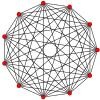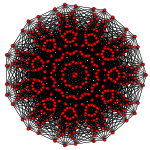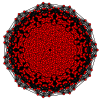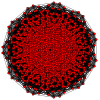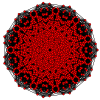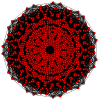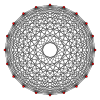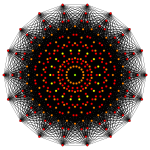In ten-dimensional geometry, a 10-polytope is a 10-dimensional polytope whose boundary consists of 9-polytope facets, exactly two such facets meeting at each 8-polytope ridge.
A uniform 10-polytope is one which is vertex-transitive, and constructed from uniform facets.
Regular 10-polytopes
Regular 10-polytopes can be represented by the Schläfli symbol {p,q,r,s,t,u,v,w,x}, with x {p,q,r,s,t,u,v,w} 9-polytope facets around each peak.
There are exactly three such convex regular 10-polytopes:
- {3,3,3,3,3,3,3,3,3} - 10-simplex
- {4,3,3,3,3,3,3,3,3} - 10-cube
- {3,3,3,3,3,3,3,3,4} - 10-orthoplex
There are no nonconvex regular 10-polytopes.
Euler characteristic
The topology of any given 10-polytope is defined by its Betti numbers and torsion coefficients. [1]
The value of the Euler characteristic used to characterise polyhedra does not generalize usefully to higher dimensions, and is zero for all 10-polytopes, whatever their underlying topology. This inadequacy of the Euler characteristic to reliably distinguish between different topologies in higher dimensions led to the discovery of the more sophisticated Betti numbers. [1]
Similarly, the notion of orientability of a polyhedron is insufficient to characterise the surface twistings of toroidal polytopes, and this led to the use of torsion coefficients. [1]
Uniform 10-polytopes by fundamental Coxeter groups
Uniform 10-polytopes with reflective symmetry can be generated by these three Coxeter groups, represented by permutations of rings of the Coxeter-Dynkin diagrams:
| # | Coxeter group | Coxeter-Dynkin diagram | |
|---|---|---|---|
| 1 | A10 | [39 | |
| 2 | B10 | [4,38 | |
| 3 | D10 | [37,1,1 | |
Selected regular and uniform 10-polytopes from each family include:
-
Simplex family: A10 [39] -



















- 527 uniform 10-polytopes as permutations of rings in the group diagram, including one regular:
- {39} -
10-simplex -



















- {39} -
10-simplex -
- 527 uniform 10-polytopes as permutations of rings in the group diagram, including one regular:
-
Hypercube/
orthoplex family: B10 [4,38] -



















- 1023 uniform 10-polytopes as permutations of rings in the group diagram, including two regular ones:
- {4,38} -
10-cube or dekeract -



















- {38,4} -
10-orthoplex or decacross -



















- h{4,38} -
10-demicube


















 .
.
- {4,38} -
10-cube or dekeract -
- 1023 uniform 10-polytopes as permutations of rings in the group diagram, including two regular ones:
-
Demihypercube D10 family: [37,1,1] -

















- 767 uniform 10-polytopes as permutations of rings in the group diagram, including:
- 17,1 -
10-demicube or demidekeract -

















- 71,1 -
10-orthoplex -

















- 17,1 -
10-demicube or demidekeract -
- 767 uniform 10-polytopes as permutations of rings in the group diagram, including:
The A10 family
The A10 family has symmetry of order 39,916,800 (11 factorial).
There are 512+16-1=527 forms based on all permutations of the Coxeter-Dynkin diagrams with one or more rings. 31 are shown below: all one and two ringed forms, and the final omnitruncated form. Bowers-style acronym names are given in parentheses for cross-referencing.
| # | Graph |
Coxeter-Dynkin diagram Schläfli symbol Name |
Element counts | |||||||||
|---|---|---|---|---|---|---|---|---|---|---|---|---|
| 9-faces | 8-faces | 7-faces | 6-faces | 5-faces | 4-faces | Cells | Faces | Edges | Vertices | |||
| 1 |

|
|
11 | 55 | 165 | 330 | 462 | 462 | 330 | 165 | 55 | 11 |
| 2 |

|
|
495 | 55 | ||||||||
| 3 |

|
|
1980 | 165 | ||||||||
| 4 |

|
|
4620 | 330 | ||||||||
| 5 |

|
|
6930 | 462 | ||||||||
| 6 |

|
|
550 | 110 | ||||||||
| 7 |

|
|
4455 | 495 | ||||||||
| 8 |

|
|
2475 | 495 | ||||||||
| 9 |

|
|
15840 | 1320 | ||||||||
| 10 |

|
|
17820 | 1980 | ||||||||
| 11 |

|
|
6600 | 1320 | ||||||||
| 12 |

|
|
32340 | 2310 | ||||||||
| 13 |

|
|
55440 | 4620 | ||||||||
| 14 |

|
|
41580 | 4620 | ||||||||
| 15 |
|
11550 | 2310 | |||||||||
| 16 |

|
|
41580 | 2772 | ||||||||
| 17 |
|
97020 | 6930 | |||||||||
| 18 |
|
110880 | 9240 | |||||||||
| 19 |

|
|
62370 | 6930 | ||||||||
| 20 |
|
13860 | 2772 | |||||||||
| 21 |

|
|
34650 | 2310 | ||||||||
| 22 |
|
103950 | 6930 | |||||||||
| 23 |
|
161700 | 11550 | |||||||||
| 24 |
|
138600 | 11550 | |||||||||
| 25 |

|
|
18480 | 1320 | ||||||||
| 26 |
|
69300 | 4620 | |||||||||
| 27 |
|
138600 | 9240 | |||||||||
| 28 |

|
|
5940 | 495 | ||||||||
| 29 |
|
27720 | 1980 | |||||||||
| 30 |

|
|
990 | 110 | ||||||||
| 31 | t0,1,2,3,4,5,6,7,8,9{3,3,3,3,3,3,3,3,3} Omnitruncated 10-simplex |
199584000 | 39916800 | |||||||||
The B10 family
There are 1023 forms based on all permutations of the Coxeter-Dynkin diagrams with one or more rings.
Twelve cases are shown below: ten single-ring ( rectified) forms, and two truncations. Bowers-style acronym names are given in parentheses for cross-referencing.
| # | Graph |
Coxeter-Dynkin diagram Schläfli symbol Name |
Element counts | |||||||||
|---|---|---|---|---|---|---|---|---|---|---|---|---|
| 9-faces | 8-faces | 7-faces | 6-faces | 5-faces | 4-faces | Cells | Faces | Edges | Vertices | |||
| 1 |

|
t0{4,3,3,3,3,3,3,3,3} 10-cube (deker) |
20 | 180 | 960 | 3360 | 8064 | 13440 | 15360 | 11520 | 5120 | 1024 |
| 2 |

|
t0,1{4,3,3,3,3,3,3,3,3} Truncated 10-cube (tade) |
51200 | 10240 | ||||||||
| 3 |

|
t1{4,3,3,3,3,3,3,3,3} Rectified 10-cube (rade) |
46080 | 5120 | ||||||||
| 4 |

|
t2{4,3,3,3,3,3,3,3,3} Birectified 10-cube (brade) |
184320 | 11520 | ||||||||
| 5 |

|
t3{4,3,3,3,3,3,3,3,3} Trirectified 10-cube (trade) |
322560 | 15360 | ||||||||
| 6 |

|
t4{4,3,3,3,3,3,3,3,3} Quadrirectified 10-cube (terade) |
322560 | 13440 | ||||||||
| 7 |

|
t4{3,3,3,3,3,3,3,3,4} Quadrirectified 10-orthoplex (terake) |
201600 | 8064 | ||||||||
| 8 |

|
t3{3,3,3,3,3,3,3,4} Trirectified 10-orthoplex (trake) |
80640 | 3360 | ||||||||
| 9 |

|
t2{3,3,3,3,3,3,3,3,4} Birectified 10-orthoplex (brake) |
20160 | 960 | ||||||||
| 10 |

|
t1{3,3,3,3,3,3,3,3,4} Rectified 10-orthoplex (rake) |
2880 | 180 | ||||||||
| 11 |

|
t0,1{3,3,3,3,3,3,3,3,4} Truncated 10-orthoplex (take) |
3060 | 360 | ||||||||
| 12 |

|
t0{3,3,3,3,3,3,3,3,4} 10-orthoplex (ka) |
1024 | 5120 | 11520 | 15360 | 13440 | 8064 | 3360 | 960 | 180 | 20 |
The D10 family
The D10 family has symmetry of order 1,857,945,600 (10 factorial × 29).
This family has 3×256−1=767 Wythoffian uniform polytopes, generated by marking one or more nodes of the D10 Coxeter-Dynkin diagram. Of these, 511 (2×256−1) are repeated from the B10 family and 256 are unique to this family, with 2 listed below. Bowers-style acronym names are given in parentheses for cross-referencing.
| # | Graph |
Coxeter-Dynkin diagram Schläfli symbol Name |
Element counts | |||||||||
|---|---|---|---|---|---|---|---|---|---|---|---|---|
| 9-faces | 8-faces | 7-faces | 6-faces | 5-faces | 4-faces | Cells | Faces | Edges | Vertices | |||
| 1 |
 |
10-demicube (hede) |
532 | 5300 | 24000 | 64800 | 115584 | 142464 | 122880 | 61440 | 11520 | 512 |
| 2 |
 |
Truncated 10-demicube (thede) |
195840 | 23040 | ||||||||
Regular and uniform honeycombs
There are four fundamental affine Coxeter groups that generate regular and uniform tessellations in 9-space:
| # | Coxeter group | Coxeter-Dynkin diagram | |
|---|---|---|---|
| 1 | [3[10] | ||
| 2 | [4,37,4] | ||
| 3 | h[4,37,4] [4,36,31,1 |
||
| 4 | q[4,37,4] [31,1,35,31,1 |
||
Regular and uniform tessellations include:
-
Regular
9-hypercubic honeycomb, with symbols {4,37,4},



















- Uniform
alternated 9-hypercubic honeycomb with symbols h{4,37,4},



















Regular and uniform hyperbolic honeycombs
There are no compact hyperbolic Coxeter groups of rank 10, groups that can generate honeycombs with all finite facets, and a finite vertex figure. However, there are 3 paracompact hyperbolic Coxeter groups of rank 9, each generating uniform honeycombs in 9-space as permutations of rings of the Coxeter diagrams.
| = [31,1,34,32,1]: |
= [4,35,32,1]: |
or = [36,2,1]: |
Three honeycombs from the family, generated by end-ringed Coxeter diagrams are:
References
- T. Gosset: On the Regular and Semi-Regular Figures in Space of n Dimensions, Messenger of Mathematics, Macmillan, 1900
- A. Boole Stott: Geometrical deduction of semiregular from regular polytopes and space fillings, Verhandelingen of the Koninklijke academy van Wetenschappen width unit Amsterdam, Eerste Sectie 11,1, Amsterdam, 1910
-
H.S.M. Coxeter:
- H.S.M. Coxeter, M.S. Longuet-Higgins und J.C.P. Miller: Uniform Polyhedra, Philosophical Transactions of the Royal Society of London, Londne, 1954
- H.S.M. Coxeter, Regular Polytopes, 3rd Edition, Dover New York, 1973
- Kaleidoscopes: Selected Writings of H.S.M. Coxeter, edited by F. Arthur Sherk, Peter McMullen, Anthony C. Thompson, Asia Ivic Weiss, Wiley-Interscience Publication, 1995,
ISBN
978-0-471-01003-6
[1]
- (Paper 22) H.S.M. Coxeter, Regular and Semi Regular Polytopes I, [Math. Zeit. 46 (1940) 380-407, MR 2,10]
- (Paper 23) H.S.M. Coxeter, Regular and Semi-Regular Polytopes II, [Math. Zeit. 188 (1985) 559-591]
- (Paper 24) H.S.M. Coxeter, Regular and Semi-Regular Polytopes III, [Math. Zeit. 200 (1988) 3-45]
- N.W. Johnson: The Theory of Uniform Polytopes and Honeycombs, Ph.D. Dissertation, University of Toronto, 1966
- Klitzing, Richard. "10D uniform polytopes (polyxenna)".
External links
- Polytope names
- Polytopes of Various Dimensions, Jonathan Bowers
- Multi-dimensional Glossary
- Glossary for hyperspace, George Olshevsky.
